
Harlowton is a city in and the county seat of Wheatland County, Montana, United States. The population was 997 at the 2010 census. The city was once the eastern terminus of electric operations (1914–74) for the "Pacific Extension" of the Chicago, Milwaukee, St. Paul and Pacific Railroad. Here, steam or diesel locomotives were changed or hooked up to electric locomotives for 438-mile (705 km) trip through the Rocky Mountains to Avery, Idaho. Harlowton was founded in 1900 as a station stop on the Montana Railroad, a predecessor to the Milwaukee, and was named for Richard A. Harlow, the Montana Railroad's president.
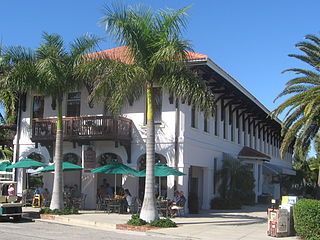
The Charlotte Harbor and Northern Railway Depot is a historic Charlotte Harbor and Northern Railway (CH&N) depot in Boca Grande, Florida. It is located at Park and 4th Streets. The station was built by the CH&N in 1910; the railroad's parent company, the American Agriculture and Chemical Company, had several phosphate mines in the area and wanted a railroad to ship its phosphate and other goods. The company played an important role in Boca Grande's early development, both by building the railroad and station and by opening a hotel and selling land. The station continued service when the railroad was acquired by the Seaboard Air Line Railroad in the 1920s. Rail service began to diminish during the Great Depression, and later during the post-World War II period, when it closed in 1958. Until its closure, the railroad was the only land connection between Boca Grande and mainland Florida.

The Atlantic Coast Line Passenger Depot was a historic Atlantic Coast Line Railroad depot in Sarasota, Florida, United States. It was located at 1 South School Avenue.

The Old Lake Placid Atlantic Coast Line Railroad Depot, now the Historical Society Depot Museum of the Lake Placid Historical Society, is a historic Atlantic Coast Line Railroad depot in Lake Placid, Florida. It is located at 12 East Park Street.

Baton Rouge station is a historic train station located at 100 South River Road in downtown Baton Rouge, Louisiana. The building now houses the Louisiana Art and Science Museum.

Oxford station was a historic train station at South Elm and West Spring Streets in Oxford, Ohio. Oxford first received railroad service in the 1850s, when a line connecting the Chicago and Cincinnati rail networks was completed through the city. The original station was replaced by a larger building in 1895. Before the rise of the automobile, the station's passenger services brought students to and from Oxford's multiple colleges, including Miami University, and its freight services shipped local agricultural products to their markets. A building known as the Junction House, located across the street from the depot, was built in 1860 and is closely associated with the railroad. Originally a grocery store, it became a hotel and tavern in 1868; while a local temperance movement closed the tavern in the 1870s, it remained a hotel until 1905 and is now an apartment building.

Two Harbors station is a historic train station located on Sixth Street in Two Harbors, Minnesota. The station was built in 1907. The large two-story depot was the third depot on the site. The Minnesota Iron Company developed the Duluth and Iron Range Railroad in 1883, laid out the town of Two Harbors in 1885, and built depots to conducts its business. When the rail line was completed to Duluth, it was used as a transfer point for passengers, lumber, and mining supplies. When passenger service ended in 1961, the depot was donated to Lake County. The building was listed on the National Register of Historic Places in 1983 as the Duluth and Iron Range Railroad Company Depot.

Staunton River Battlefield State Park is a state park located in Virginia. The park straddles the Staunton River in Halifax and Charlotte counties. The Roanoke visitor center in Randolph, Virginia is a railroad depot which now holds exhibits on Native Americans and railroad history. The Clover visitor center has exhibits on the American Civil War and the battle which took place on this site. It also includes information about the production of electric energy. The park also includes the Mulberry Hill plantation, given to the state in 1999.

The Chicago, Rock Island and Pacific Railroad Passenger Station is a historic building located in Iowa City, Iowa, United States. Built in 1898 for passenger use, it was the second depot in the city. The first one was built by the Mississippi and Missouri Railroad, a predecessor of the Chicago, Rock Island and Pacific Railroad (CRI&P), in 1855. This one was built through the efforts of Harry Breene, the local Rock Island agent. W.K. McFarlin, CRI&P's superintendent of maintenance and construction oversaw the building's construction. Architecturally, it is a combination of the Richardsonian Romanesque and Victorian Romanesque. The depot was built to similar designs of stations in Ottawa, Illinois, and Council Bluffs, Iowa. Service included the CRI&P's Corn Belt Rocket and Rocky Mountain Rocket passenger lines. The depot ceased operations in 1970, although the railroad continued to maintain offices here. In 1982 it was acquired by a couple of attorneys for their offices. It was listed on the National Register of Historic Places the same year. The building sits adjacent to the Iowa Interstate Railroad lines, and the railroad has operated occasional excursion trains that have stopped at the former depot.

Anchorage Depot, also known as Alaska Railroad Depot, is the railroad station at the center of the Alaska Railroad system at the junction of the two main lines their trains run on. It serves as the starting point for many tourists traveling on the luxury trains such as the Denali Star. The station is a Moderne-style three story concrete building, built in 1942 and enlarged in 1948.
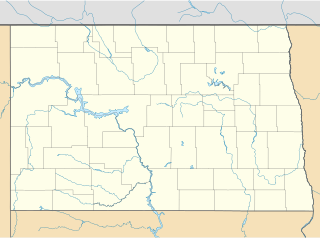
Amenia station is a historic railroad station in Amenia, North Dakota, United States. It was built in 1880, and was designed and/or built by the Northern Pacific Railroad. The depot served Amenia until 1974. It was listed on the National Register of Historic Places in 1977 as the Burlington Northern Depot, and delisted in 2016.

City Hotel, also known as Seifert's Tavern and the Wheatland Feed Mill, on 214 South Main Street in Wheatland, Iowa was listed on the National Register of Historic Places for Clinton County, Iowa in 2007.
The Virginia & Truckee (V&T) Railroad Depot of Carson City, Nevada is a historic railroad station that is listed on the U.S. National Register of Historic Places (NRHP). It is significant for its association with the economically important role of the V&T railroad historically in Carson City following discovery of the Comstock Lode mine in 1859. To a lesser degree, according to its NRHP nomination, the depot building is also significant architecturally "as a well-preserved example of a wood-frame passenger depot procured from a railroad company pattern book within the V&T's former sphere of operation."

The Riverton Railroad Depot is a historic railway station located at 1st and Main Streets in Riverton, Wyoming. The depot was built by the Chicago and North Western Railway from 1906 to 1907 along a new line through central Wyoming built by the railway in 1906. The city of Riverton formed only two weeks before the railroad reached it when land in the area opened to new residents under the Homestead Act. The railroad spurred economic development in the region by exporting agricultural products and oil and creating demand for the local coal and lumber industries. When the railroad industry declined after World War II, the Chicago and North Western gradually decreased its service west of Casper, and by 1974 it was prepared to demolish the Riverton station as well. A group of Riverton residents instead bought and restored the depot, which now houses businesses. Some claim that the depot is the last surviving Chicago and North Western station west of Casper, but, although modified, the Lander station, still stands and is currently home to the Lander Chamber of Commerce.
Cloverdale is a bus station and future intermodal station in Cloverdale, California. It is served by Amtrak Thruway and Sonoma County Transit buses. Additional service to Sonoma County Airport station is provided by Sonoma County Transit under contract by Sonoma–Marin Area Rail Transit.
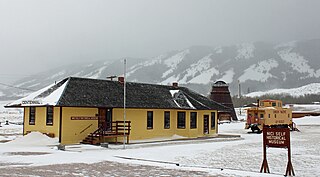
The Centennial Depot, also known as the Nici Self Historical Museum, was built in 1907 for the Laramie, Hahn's Peak and Pacific Railway in Centennial, Wyoming, United States. In addition to railroad services, the depot housed a post office and, at times, a grocery store. The depot was operated by the Union Pacific Railroad until the early 1970s. Demolition was proposed, but the depot was purchased by the Centennial Valley Historical Association, which moved it a short distance to its present site. It is operated as the Nici Self Museum.

P. C. C. & St. L. Railroad Freight Depot, also known as the Central Union Warehouse, was a historic freight depot located at Indianapolis, Marion County, Indiana. It was built in 1916 by the Pittsburgh, Cincinnati, Chicago and St. Louis Railroad. It was a one-story, brick warehouse building measuring 790 feet long and 70 feet wide. It has been demolished.

The Chicago, Milwaukee, St. Paul & Pacific Combination Depot-Hornick, also known as the Hornick Depot, is a historic building located in Hornick, Iowa, United States. The town was patted by the Chicago, Milwaukee, St. Paul & Pacific Railroad's land company when the railroad created a branch line from Manilla, Iowa to Sioux City. Completed in 1887, the railroad built this two-story frame structure to serve as its passenger and freight depot. It is one of six such depots that remain in Iowa, and the best preserved. These buildings were built from a standard design used by the railroad. The two-story stations included living quarters for the station manager because the towns had yet to develop when the depot was built. This was an island depot, with freight loaded on the north side and passengers boarded on the south. Decorative elements on this depot include lathe-turned wooden finials, angled wooden brackets, and bracketed door and window hoods. Passenger service ended in the 1950s, and grain was loaded here until 1980 when the Milwaukee Road abandoned the Sioux City branch line. The building was listed on the National Register of Historic Places in 1990. It has been converted into a local history museum.
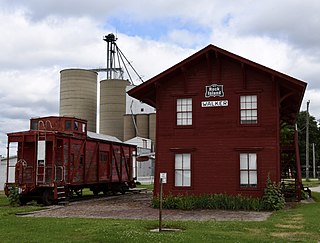
Walker Station is a historic building located in Walker, Iowa, United States. The two-story frame building with bracketed eaves was completed in 1873 along the Burlington, Cedar Rapids, and Minnesota Railway tracks. The depot also served its successor railroads: the Burlington, Cedar Rapids and Northern, and the Chicago, Rock Island and Pacific. Typical of many railroad towns in the Midwest, this is the first building that was built here and the town grew up around it. It is an example of a combination depot that was used for both passenger and freight usage in smaller communities. Because it has a ground level brick platform, service here was primary passenger and light freight service. A higher level of freight service would have required a raised platform.
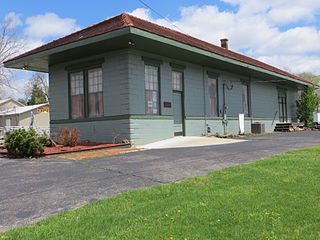
The Louisville, Henderson, and St. Louis Railroad Depot in Fordsville, Kentucky was built in 1916. It was listed on the National Register of Historic Places in 1991. It is located on the southeastern side of Walnut St., 200 feet (61 m) north of its junction with Kentucky Route 54.



















